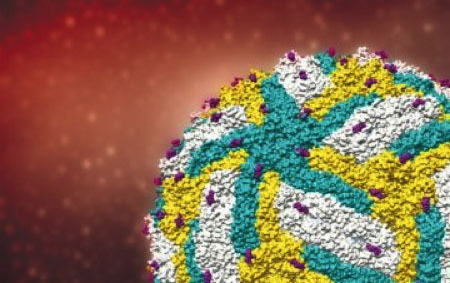Structure Reveals Strategy to Attack Zika Virus

Recent outbreaks of Zika virus infections have created a great need to find a therapeutic strategy against this potentially debilitating pathogen. Most commonly transmitted by mosquito bites in endemic regions such as central and South America, it can also be transmitted from mother to child during pregnancy, through sexual contact, or from blood transfusion. Although symptoms of Zika virus infection can be nonexistent or nonspecific like fever, skin rashes, conjunctivitis, muscle and joint pain, malaise, or headache, the virus has been associated with severe complications such as smaller brains in infants (microcephaly) or peripheral nerve damage in adults (Guillain-Barré syndrome). Currently there is no treatment or vaccine available for the virus. Researchers from Duke-National University of Singapore Medical School and National University of Singapore recently determined the molecular structure of the Zika virus using cryo-electron microscopy. Even though the virus looks similar to others in its family (flavivirus), such as West Nile virus and dengue virus, its molecular structure revealed that it has a much more compact surface that keeps it stable at temperatures as high as 40 C and in the harsh conditions of semen, saliva, and urine. This unique feature explains why the virus may not be destroyed by fevers and can be transmitted through sexual contact, unlike other similar viruses. By identifying the molecular bonds holding up its stability, this study provides a blueprint with which to design antibodies or small molecule inhibitors to destabilize its structure as a strategy to limit its spread or disease outcomes.
References
- Kostyuchenko VA, Lim EX, Zhang S, et al. Structure of the thermally stable Zika virus. Nature. 2016;533:425-428. doi: 10.1038/nature17994.








